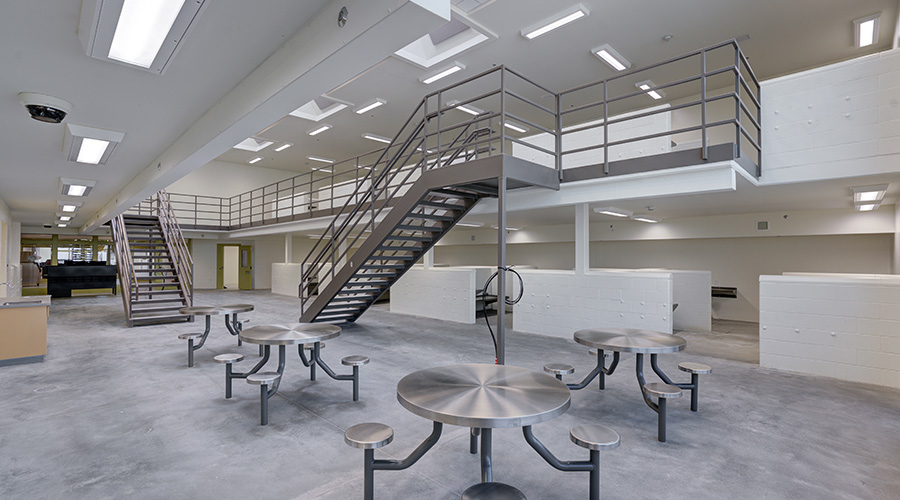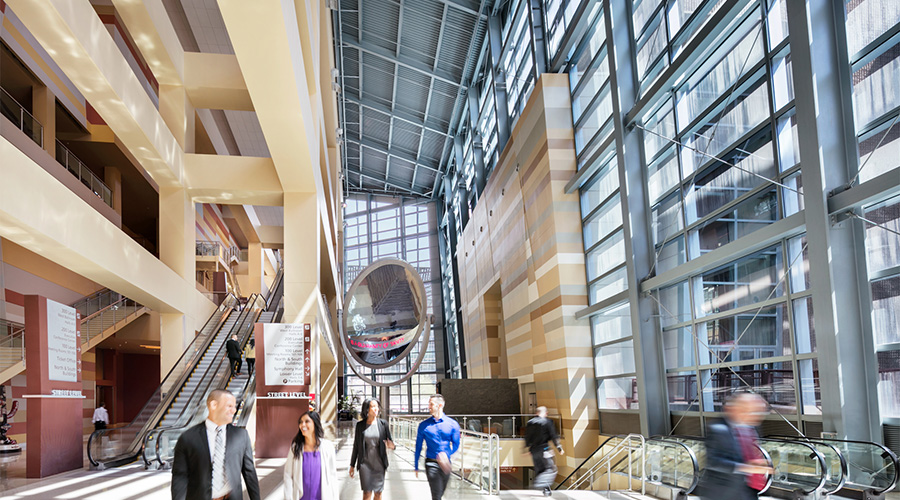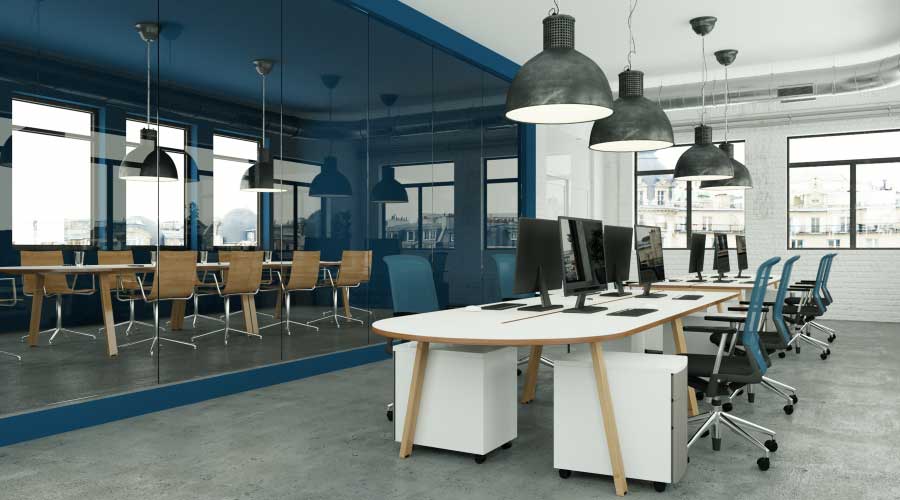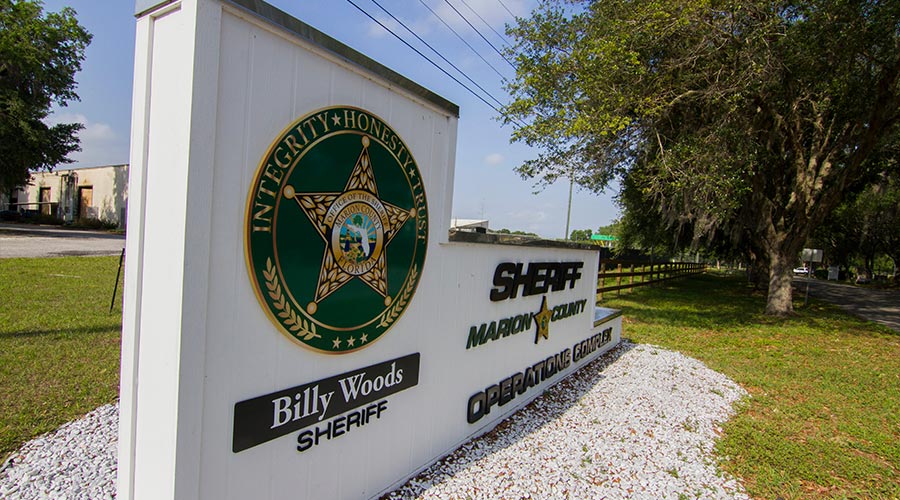 Lighting plays an important role in supporting staff and inmate safety. Luminaires that have doorless-style housings firmly secured to the ceiling ensure there are no crevices or gaps to enable tampering, making the fixture virtually impenetrable. Kenall Manufacturing
Lighting plays an important role in supporting staff and inmate safety. Luminaires that have doorless-style housings firmly secured to the ceiling ensure there are no crevices or gaps to enable tampering, making the fixture virtually impenetrable. Kenall ManufacturingUtah State Correctional Facility Improves Conditions for Inmates and Employees
Natural light and design-savvy features aid in facilitating rehabilitation and staff productivity
Safety, security and comfort were key pillars considered when designing the recently completed Utah State Correctional Facility (USCF) in Salt Lake City. The transition team focused on including design elements that would not only improve inmate comfort and rehabilitation but also create better working conditions for officers and staff members.
“Our old prison was old … some of our buildings had no air conditioning. Some of our buildings had poor heat or lighting or infrastructure, so that was one of our big goals — just to get better living conditions,” says Jerry Jensen,deputy director of facilities management, Utah Department of Corrections. “On the other end, we wanted to get better classrooms and better opportunities for the inmates.”
The $1.5 billion correctional facility, which replaces the long-outdated Utah State Prison that opened in 1951, incorporates a direct-supervision model that was approved by the Department of Correction and the State of Utah Division of Facilities Construction and Management.
The direct-supervision model is a prison management system that involves correctional officers being in constant contact with inmates. For this type of model to be effective, the physical design of the prison must work with the management strategy to reduce barriers between staff and inmates and promote positive behavior. This ultimately leads to safer jails, better inmate control, and more positive relationships between staff and inmates.
Adding natural light
The prison, which spans 1.3 million square feet and accommodates 3,600 inmates of all classifications, was intentionally designed to incorporate natural daylight and secure spaces that feel less like a prison. One unique aspect of this design was shifting to a linear model of housing where cells are arranged on either side of a rectangle around a dayroom. At one end are floor-to-ceiling windows that let in natural light and views of the surrounding mountains.
Research shows that a prison population’s surroundings play a crucial role in psychological rehabilitation. Lighting in particular can have a major impact on a person’s moods, emotions and behavior. Studies show that exposure to natural light helps to regulate circadian rhythms, contributing to improved moods and cognitive function. Exposure to sunlight also increases the release of serotonin in the brain, a neurotransmitter that contributes to peace and well-being and is crucial in preventing psychological disorders such as stress, anxiety or depression.
“If you can change their behavior inside the facility, our goal is to change their behavior all the way around,” says Jensen. “Our goal is to make things more normal … at home, you don't have a room this dark all the time … you have daylight, and you let people come out and have daylight, and that's what we tried to give them. We give them more rec time. We give them a little bit more time outside, more normal.”
This idea to provide more normal accommodations was also achieved by designing many areas with standard lay-in ceilings and light fixtures, helping to eliminate that prison-like environment, according to Dave Wesemann, president and CEO Spectrum Engineers, the electrical engineering firm for this project.
With dedicated units for both men and women, the facility also includes mental health housing that provides acute mental health and substance abuse treatment; medical facilities, including space for clinical examination, optometry, dentistry, dialysis, phlebotomy and physical therapy; classrooms; kitchen; laundry; religious spaces; and room for future expansion.
“One of the overall goals of this project was to provide a better environment for inmates in which they can more effectively rehabilitate and enter back into society,” Wesemann says.“The project provided much more daylighting than typical prison designs and is generally a more open environment where officers are in dayrooms with inmates rather than behind glass in a control room.”
While the original prison had very limited to no windows to the outside, USCF was designed to allow for as much natural light as possible in consideration with safety and security measures.
“We had quite a few people tell us we couldn't do that in a prison, and through design and engineering we did,” says Jensen.
The result has quite literally been day and night, leading to improved behaviors from inmates and staff members.
“It was a very hard emotionally for the inmates, but also our own staff,” says Jensen. “Our shifts are 6 (a.m.) to 6 (p.m.). We had officers coming to work in the dark, going home in the dark. The new facility, by design, has total natural light, and we’re not talking just little teeny windows. We’ve got it to where the whole end of the section is open. We’ve got total view of the mountains on the one side and the lake on the other side.”
Along with the addition of windows and more natural light, the offenders were given night lights in their cells to allow for more opportunities to use lighting after dark.
“At the other facility, when it was lights out, it was lights out,” says Jensen. “At this one, we decided that if they're having problems sleeping or whatever, rather than just sit there and lay in the dark, they would be able to read and be productive with their time.”
Because the addition of night lights is especially unique in prison design, Wesemann says the Utah Department of Corrections was very particular about the level of night in the cell areas.
“Too much light would be a nuisance to the inmates; not enough would not allow roaming officers to sufficiently see to be sure all is well,” says Wesemann.“We went through a mock-up process to adjust the night light levels in the light fixtures.”
Amy Wunderlin is a freelance writer based in Fort Atkinson, Wis.
Related Topics:













